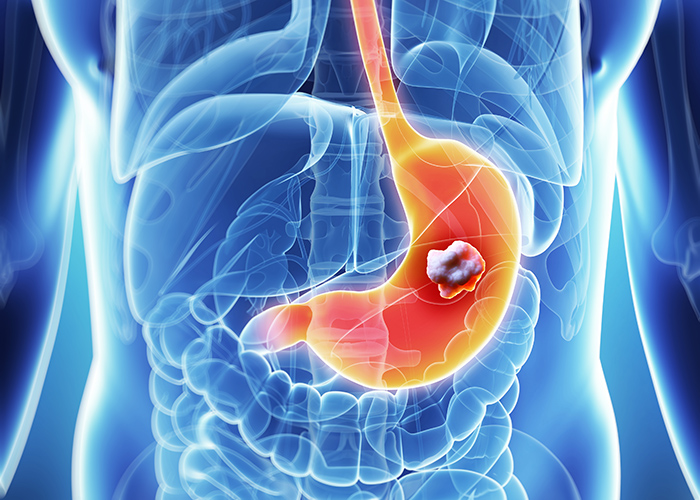By DR. T. VISHNU MURTHY
Stomach cancer, also known as gastric Cancer, is a condition in which abnormal cells grow in the stomach lining. There are three main forms of stomach cancer: scirrhous, carcinoma medullaris, and carcinoma alveolaris. These cancers can often be found together and typically affect the pylorus, but they can also impact the cardia, lesser curvature, and other stomach parts. The causes of stomach cancer are not well understood, but factors such as weakness in certain parts of the stomach, heredity, and age can play a role.
According to the researches, there are three different forms of Cancer in the stomach:
1. Scirrhous, a fabulous growth in which the connective tissue stroma predominates over the cell formation, generally originates in the submucous cellular tissue.
2. Carcinoma medullaris, a narrow-like growth in which cancer cells predominate over the stroma, forms round isolated lumps in the mucous membrane of the stomach.
3. Carcinoma Alveolaris, a jelly-like growth in which we observe a colloid degeneration of the cancer cells, invests as first the sub-mucous cellular tissue but frequently penetrates to the peritoneum and forms a large tumour upon it. All three kinds of Cancer may often be seen together, and they must invest the pylorus, sometimes the lesser curvature, still rarer the cardia, and most rarely other parts of the stomach.
The diseased pylorus often forms adhesions with adjoining organs, such as the pancreas, liver, kidneys, and colon, which are mostly invested by the same morbid product, keeping the stomach in a fixed position. When however, adhesions do not take place, the stomach sinks, in consequence of its increased weight, lower down into the abdominal cavity, remaining there, either perfectly free and movable or adhering to organs lower down, such as portions of the intestines, the uterus, or its appendages.

This disease changes the inner cavity of the stomach. It becomes greatly enlarged by the structure of the pylorus or much diminished by the structure of the cardia; there is cancerous degeneration of the coatings of the stomach. The mucous membrane, in the neighbourhood of the Cancer, exhibits chronic catarrhal inflammation, which is sometimes spread all over it; and in the further progress of the disease, ulceration and erosion of smaller or larger blood – vessels with consecutive haemorrhage obtain.
The causes of carcinoma in the stomach we do not know, just as the causes of Cancer in any part of the body. According to my research, whichever organ in the stomach is getting weak frequently can affect carcinoma or heredity and deserves some consideration. The disease has been observed most often between fifty to seventy.
SYMPTOMS:
1) General cancer – cachexia; emaciation; paleness of the skin and the mucous membranes; ash-coloured or yellowish colour of the face; brittle; dry, harsh, and wrinkled skin; peeling of branny scales, especially from lower extremities. The expression of the face is sad; the eyes are fallen in; the malar bones stick out; the ankles are edematous.
2). Tumour in the pit of the stomach: This is present, however, only when the Cancer invests the pylorus. In this case, we observe a roundish, oval, or irregular lump to the right above the navel under the upper part of the right rectus abdominal muscle. It is always there and cannot be moved, of the pylorus should have formed adhesions with neighbouring organs, but it changes position and is movable when those adhesions are not moved. In this latter case, it gradually sinks into the abdominal cavity. It may appear below the navel or a little above the symphysis pubis as a movable or fixed tumour. But it cannot be felt when the pylorus-carcinoma is covered by the left lobe of the liver or by a distended colon. The same is true when carcinoma sits on the cardia or the lesser curvature. Cancerous degeneration of the anterior wall of the stomach is felt as a resisting mass in the epigastrium, changing position. However, the stomach may be felt more towards the right or towards the left side, higher up or lower down, even below the navel.
3). The stricture of the pylorus causes further sinking in of the abdomen; the intestines are empty because the food is prevented from going through the pylorus; the abdominal walls are thin, wrinkled, like parchment; they may be lifted up in folds which remain the subcutaneous cellular tissue is wasted away, and the full percussion sound is wanting. The spine even may be felt through the abdominal walls, and the aorta descendens pulsates perceptibly. When there is a structure of the cardia, the epigastric region is fallen in because insufficient nourishment is allowed to enter the stomach; the intestines are likewise empty, and only the ribs and the processus xyphoideus protrude.

4). Vomiting This happens if there is a stricture of the pylorus, generally from four to five hours after eating. The masses which are thrown up are digested. In the case of stricture of the cardia, the vomiting takes place immediately after or even during eating, without nausea or exertion; it is only a regurgitation of the swallowed food. If the esophagus’s diverticles or widenings exist simultaneously, the vomiting follows a little later. The masses which are thrown up are the same swallowed. If the Cancer has its seat in another part of the stomach, the vomiting may be absent; after being regular for a time, it may slacken off and cease altogether. So also, the vomiting may cease if the stricture of the pylorus, by softening, gets removed or if the walls of the stomach, by diffused cancerous degeneration, lose all power of contractions.
5). Haemorrhages from the stomach. The blood is thrown up either decomposed as a brownish, chocolate-like mass or when larger blood vessels have been destroyed as clear blood.
6). The pain in the epigastrium, which has its seat generally in the cancerous Tumour, is worse from eating, usually of a lancinating or burning character, and never extending to the spine; it may be absent altogether.
7). The appetite is generally diminished; in some cases, however, it is increased; but the patients are afraid to eat because of the following pain and vomiting.
8) The stool is usually retarded; but when the cancerous growth softens and dissolves, we observe colliquative diarrhoea, and when there is haemorrhage in the stomach, bloody evacuations.
Cancer is distinguished from cardialgia in that it grows uninterruptedly and gradually, while cardialgia comes in spells, with intervals of health; further, by the age of the person, and its inroads upon the general constitution.
Treatment is based on the pulse test, and the body condition will be given medicine by the preparation of individual formulas.

Leave a Reply